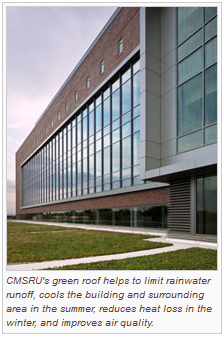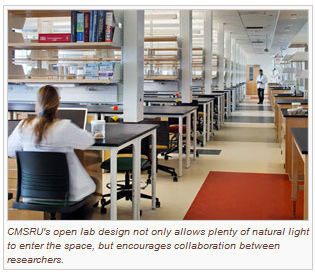CMSRU receives Gold LEED Certification from U.S. Green Building Council
 April 22, 2013 was officially Earth Day, and Cooper Medical School of Rowan University (CMSRU) was thrilled to learn (coincidentally) a few days before that our new medical education building received Gold Leadership in Energy and Environmental Design (LEED) certification from the U.S. Green Building Council (USGBS). This is the second LEED certification for a Rowan University building – the Samuel H. Jones Innovation Center at the South Jersey Technology Park in Mantua Township achieved LEED Silver certification in 2009.
April 22, 2013 was officially Earth Day, and Cooper Medical School of Rowan University (CMSRU) was thrilled to learn (coincidentally) a few days before that our new medical education building received Gold Leadership in Energy and Environmental Design (LEED) certification from the U.S. Green Building Council (USGBS). This is the second LEED certification for a Rowan University building – the Samuel H. Jones Innovation Center at the South Jersey Technology Park in Mantua Township achieved LEED Silver certification in 2009.
It's a complex building, sitting in the heart of Camden. Robust research and teaching laboratories, all sizes of high-tech classrooms, warm but efficient administrative offices, bright gathering spaces – these are the spaces through which the students, faculty, and staff of CMSRU pass every day. It was a building constructed around the idea of an innovative curriculum, driven by the need for a new approach to medical education and healthcare in this city, in this region, and in this country.
Construction was challenged by multiple major snows in the winter of 2010-11, record rainfall in the summer of 2011, two hurricanes (Irene and Sandy), an earthquake (yep, in New Jersey – remember the 5.8 Virginia one?), and of course, one of the worst economic downturns in the country since the Great Depression. But despite all of these challenges, the team working on this building managed to deliver a beautiful building on time, under budget, and with the announcement from the U.S. Green Building Council – one of the most energy efficient and sustainable buildings of its size in the region.
What makes a building "green" according to the USGBC? Some things are obvious – installation of a green roof, use of natural light for indoor spaces, recycling of construction materials, use of sustainable materials in the building (including the furniture!). Other things might be less obvious, such as the installation of bike racks (we have lots), access to public transportation (trains stop 2 blocks away), and use of regional materials (less energy used in transportation). Our team worked diligently to fulfill the requirements to ultimately get to Gold certification (the highest level is Platinum – we're one level below that).
 Of course, energy efficiency and sustainability doesn't stop when the ribbon is cut – CMSRU continues to work on being as green as possible. We have single-stream recycling, our servery composts food waste, and we have occupancy sensors throughout the building so that areas that are not being used don't continue to be heated, cooled, or lighted. We discourage printing if at all possible (we routinely send out e-vites instead of printed invitations), and print double sided when we absolutely MUST have something on paper. And when we're done with the paper, of course, we recycle it!
Of course, energy efficiency and sustainability doesn't stop when the ribbon is cut – CMSRU continues to work on being as green as possible. We have single-stream recycling, our servery composts food waste, and we have occupancy sensors throughout the building so that areas that are not being used don't continue to be heated, cooled, or lighted. We discourage printing if at all possible (we routinely send out e-vites instead of printed invitations), and print double sided when we absolutely MUST have something on paper. And when we're done with the paper, of course, we recycle it!
CMSRU's construction and design team included HDR Architecture (lead architect/engineering), the Camden County Improvement Authority (financing and project management), Joseph Jingoli & Son (construction management), Greyhawk (owner's rep/commissioning), The Bedwell Company (foundation/steel/general construction), WPCS International (electrical), Dolan Mechanical (HVAC), and Falasca Mechanical (plumbing).